|
The Cornhill Magazine, 1860–1975 | |
Sequence |
Volumes 1–10, 1860–64 |
Editor |
William Makepeace Thackeray, 1860–62 |
Publisher |
Smith, Elder and Co., 1860–1916 |
Printer |
Smith, Elder and Co., 1860–99 |
Price |
1s (1860) |
Format |
Royal 12mo. |
Pages |
128 (1860) |
Frequency |
Monthly |
Circulation |
87,500 (1860), 40,00 (1864) |
Indexes |
All volumes: Table of Contents, List of Illustrations |
Copies |
Sheffield University Library (vols. 1–10) |
Introduction | |
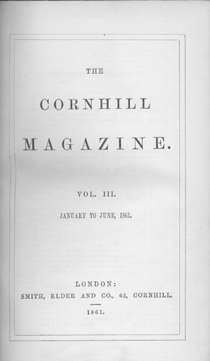 By the close of the 1860s there were, according to the publisher William Tinsley, 'more magazines in the wretched field than there were blades of grass to support them' (Quoted in Altick 1998, p. 359). The boom in mid-Victorian magazine publishing had begun at the end of the previous decade with the emergence of a new, and innovatively priced, genre of periodicals with which entrepreneurial publishers sought to exploit new sectors of the mid-Victorian reading public. These so-called 'shilling monthlies' successfully utilised the new modes of literary production available in mid-Victorian Britain to provide a form of relatively inexpensive periodical that was eagerly purchased by an unprecedentedly large—and as yet largely untapped—middle-class readership. They appealed to the widest possible range of readers, from both sexes as well as across generations, by combining high quality non-fictional essays that often constructed their audience as male, with high-profile novels, stories and poems, which were aimed largely at female readers. Although monthly literary miscellanies like Blackwood's Edinburgh Magazine had been in existence since the 1810s, the new shilling monthlies were considerably cheaper (Blackwood's sold for 2s 6d), less politically sectarian, and placed a much greater emphasis on the kinds of fictional writing—and serialized novels in particular—that had become fashionable since the 1840s. This hybridity and deliberate inclusiveness gained the first shilling monthlies an exceptionally large circulation, with the Cornhill Magazine famously selling 120,000 copies of its opening number. Although the Cornhill, with William Makepeace Thackeray at its helm, quickly gained the biggest share of the market, its principal rivals, Macmillan's Magazine and Temple Bar, were nevertheless selling 20,000 and 30,000 copies respectively during the early 1860s. Both in terms of price and frequency of publication, shilling monthlies were balanced precariously between expensive quarterlies like the Edinburgh Review and grubby penny weeklies such as the London Journal. They appealed primarily to those sectors of the mid-Victorian reading public who were previously served neither by the expensive monthly and quarterly titles of the metropolitan intellectual elite nor by the much cheaper weekly journals aimed at a more popular, and sometimes semi-literate, audience. At the Cornhill, Thackeray sought to attract a family audience by proposing that while the magazine would both 'amuse and interest' its different constituencies of readers, it would never be forgotten that 'ladies and children [were] always present' at its diverse 'social table' (Ray, ed. 1946, 4:161). Similarly, he maintained a self-imposed moratorium on controversial subjects like religion and politics which ensured that the magazine's audience was never confined to readers of particular parties or sectarian groups, and in this way shilling monthlies like the Cornhill resembled other forms of middle-class public culture such as Literary and Philosophical Societies, which regularly enforced a rule of 'no religion, no politics' at their gatherings. 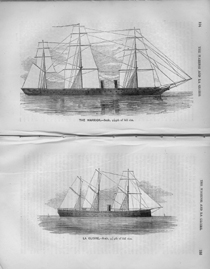 The Cornhill and its principal rival Macmillan's were both founded by leading publishers eager to increase the market for their books, and George Smith and Alexander Macmillan frequently used their respective magazines not only to 'trail' forthcoming titles from their publishing companies, but also to advertise their numerous other wares. The abundant financial backing that these arrangements afforded each title was particularly necessary in a literary marketplace that, especially after the repeal of duty on paper in 1861, was becoming increasingly crowded and competitive. Before the Cornhill was launched, Smith had exhausted a huge advertising budget of £5,000 ensuring that even the most isolated members of the mid-Victorian reading public could not remain unaware of his imminent foray into magazine publishing. Additionally, Thackeray, one of the most eminent English writers of the previous two decades, had been hired as editor, on extremely generous terms, partly in order to add an instant distinctiveness and celebrity renown. For Thomas Carlyle, as for many other readers, the Cornhill was immediately identifiable as 'the Thackeray magazine', and Smith later recalled how 'His very name as editor gave the new magazine distinction' (Ray, ed. 1946, 4:158; quoted in Schmidt 1983, p. 8). Thackeray's expensively acquired editorial imprimatur undoubtedly made the Cornhill more attractive as a commodity in a heavily saturated literary marketplace. 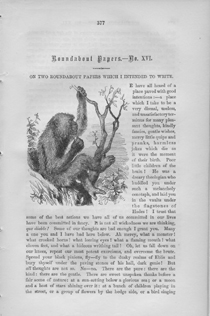 Ironically, however, the stunning success of the Cornhill's initial numbers only helped to make the market for periodicals still more competitive. A range of imitative shilling monthlies, many also taking their titles from fashionable districts of London like Temple Bar, St. James's Magazine and Belgravia quickly sprang up, often with former Cornhill employees at the helm (George Augustus Sala, for instance, left the Cornhill to become the editor of Temple Bar). Each of these new journals fought extremely hard to secure what the Economist termed 'that limited share of public attention which is requisite to keep a monthly shilling magazine afloat', and, as George Henry Lewes, a stalwart of the Cornhill, later conceded, although 'they all resembled the "Cornhill" in general ... each added some special attraction of its own' (Baker, ed. 1995–99, 2:71). With the middle-class audience for such magazines enjoying a greater choice than ever before, more established shilling monthlies like the Cornhill found it increasingly difficult to keep abreast of changes in the literary marketplace as well as the shifting tastes of their readers. Meanwhile, Thackeray's health had begun to decline, and following his departure in March 1862, Smith himself took over as editor, although sharing his responsibilities with an editorial committee consisting of Lewes and Frederick Greenwood. Lewes in particular saw this as an opportunity to attract new, more intellectually refined readers by adding specialist departments to the magazine. When Thackeray resigned, the Cornhill was still selling over 70,000 copies each month, but by the following year its circulation had fallen to around 50,000 and another 10,000 readers were lost over the next twelve months. As well as Lewes's abortive attempt to render the magazine more intellectually stimulating, this precipitous decline in circulation was also attributable to the loss of Thackeray's distinctive cachet, although he continued to contribute to the magazine until his death in December 1863, and, perhaps most importantly, the saturation of the literary marketplace, especially with new and considerably cheaper weekly magazines. During the first few years of its existence, though, the Cornhill was perhaps the most exciting phenomenon in Victorian magazine publishing, and it remains one of the best-known and most celebrated of all nineteenth-century periodicals. | |
Notes on Indexing | |
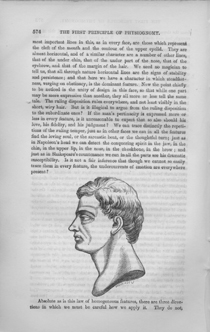 From the very outset, the Cornhill included prominent articles on scientific subjects alongside its usual diet of serialized fiction and poetry, often tackling topical issues, such as engineering, manufacturing or surgery, that addressed the professional concerns of its largely middle-class readers. In the open letter to contributors and readers printed in the first number, Thackeray insisted that fiction must form 'only a part, of our entertainment', urging that the new magazine should also have 'as much reality as possible', including 'familiar reports of scientific discovery' (Ray, ed. 1946, 4:160). While the Cornhill never attracted the same calibre of scientific contributors as Macmillan's, several prominent men of science were nevertheless enlisted to help behind the scenes. Within the first few weeks of the magazine's existence, for instance, Thackeray had 'asked Sir R[oderick]. Murchison ... who could help us', to which the Geological Survey's Director-General responded by forwarding 'the names of [certain] able and popular scientific writers' (Harden, ed. 1994, p. 1004). The Cornhill's lead item was always the next instalment of one of the current serial novels, but moving 'back into the world' and away from mere 'novel spinning' was a central plank of Thackeray's editorial agenda, and the balanced discussion of contemporary scientific issues was an essential constituent of the hybrid mix of subjects that made up the shilling monthly formula (Ray, ed. 1946, 4:158). Because details of the title and authors of the Cornhill's many specifically scientific articles are easily available, most notably in the The Wellesley Index to Victorian Periodicals 1824-1900, a considerable amount of original interpretative and contextual material has been included in the SciPer Index, so that, for instance, the entries for Lewes's 'Studies in Animal Life' provide details of the publishing history of this famous series of articles, as well as information on the particular readership to which they are addressed. 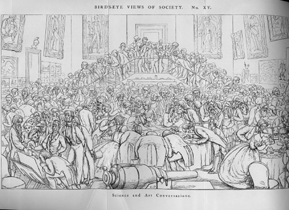 The Cornhill was, of course, primarily a literary-orientated magazine, and it regularly published fiction by some of the most notable novelists of the Victorian age, including, during the five years covered by the Index, Thackeray, Anthony Trollope, Elizabeth Gaskell, George Eliot and Wilkie Collins. Significantly, subjects pertaining to science, technology and medicine were discussed and debated extensively in all of the different genres published in the Cornhill, both fictional and non-fictional, and the Index contains entries indicating and explaining scientific references in fiction by all of the canonical authors above, as well as numerous less renowned novelists and writers of shorter fiction. The scientific interests of Eliot are, of course, well known, but other prominent novelists like Thackeray and Trollope have generally been portrayed as deliberately eschewing anything to do with the vulgar concerns of science. The Index, however, rewrites such familiar critical assumptions, revealing, for instance, that Trollope, in his novella The Struggles of Brown, Jones, and Robinson (serialized in the Cornhill during 1861), engaged directly with the highly topical issues raised by Darwin's recently published On the Origin of Species (1859). Indeed, in the chapter entitled 'The Division of Labour', the novella's droll narrator makes an explicit reference to a particular passage in the Origin's thirteenth chapter ('Mutual Affinities of Organic Beings') when he wryly eulogises 'Competition, that beautiful science of the present day, by which every plodding carthorse is converted into a racer'. In fact, the Index, by deliberately giving equal weight to all these different forms of scientific reference, reveals that non-fictional representations of science, technology and medicine in the Cornhill were often contested, both explicitly and implicitly, in the magazine's fiction and poetry. In the vigorous debate over spiritualism to which the Cornhill played host in the early 1860s, for example, these genres afforded a space in which literary figures—and women writers in particular—could offer a range of alternative perspectives to the authoritative proclamations and superciliously disdainful rhetoric put forward by men of science elsewhere in the pages of the same magazine. The Index, by foregrounding such intertextual connections, makes clear the extent of the involvement of science, technology and medicine in the wider culture of mid-Victorian Britain. | |
Bibliography | |
Altick Richard D. 1998 [1957]. The English Common Reader: A Social History of the Mass Reading Public, 2nd edn., Columbus: Ohio State University Press Baker, William, ed. 1995–99. The Letters of George Henry Lewes, 3 vols, Victoria, B.C.: University of Victoria Dawson, Gowan 2002. 'Stranger Than Fiction: Spiritualism, Intertextuality, and William Makepeace Thackeray's Editorship of the Cornhill Magazine, 1860–62', Journal of Victorian Culture, 7, 220–38 Dawson, Gowan 2004. 'The Cornhill Magazine and Shilling Monthlies in Mid-Victorian Britain', in Science in the Nineteenth-Century Periodical: Reading the Magazine of Nature, ed. by Geoffrey Cantor et al, Cambridge: Cambridge University Press Eddy, Spencer L. 1970. The Founding of the Cornhill Magazine, Muncie, Ind.: Ball State University Glynn, Jennifer Prince of Publishers: A Biography of George Smith, London: Allison and Busby Harden, Edgar F., ed. 1994. The Letters and Private Papers of William Makepeace Thackeray: A Supplement to Ray, New York and London: Garland Ray, Gordon N., ed. 1946. The Letters and Private Papers of William Makepeace Thackeray, 4 vols, London: Oxford University Press Schmidt, Barbara Quinn 1983. 'The Patron as Businessman: George Murray Smith (1824–1901)', Victorian Periodicals Review, 16, 2–14 Schmidt, Barbara Quinn, ed. 1999–2000. Special Issue: Cornhill Magazine I and II, Victorian Periodicals Review, 32–33 Sutherland, John 1986. 'Cornhill's Sales and Payments: The First Decade', Victorian Periodicals Review, 19, 106–08 | |
Gowan Dawson | |
© Science in the Nineteenth-Century Periodical Project, Universities of Leeds and Sheffield, 2005 - 2020
Printed from Science in the Nineteenth-Century Periodical: An Electronic Index, v. 4.0, The Digital Humanities Institute <http://www.sciper.org> [accessed ]